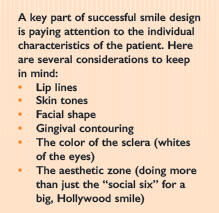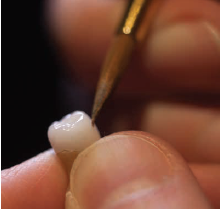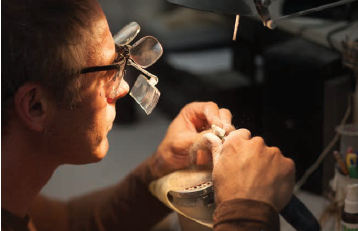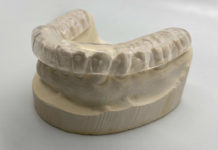
Get the “Wow!” Factor with Customized Smile Design.
We’ve all seen them: poorly made, ill-designed crowns. Because they are often opaque and non-symmetrical, they stand out in a person’s smile like a beacon that you can see a mile away. Unfortunately, sometimes crowns or veneers lack that “Wow!” factor when a case is done. It is easy for anyone to see the difference between a poor case and a good case. But what is it that distinguishes a case that is merely adequate from one that is great?
Designing a customized smile is partly a technical and partly an artistic endeavor. The job isn’t all about aesthetics—any good case includes beautiful form as well as proper function. Tooth height, width, and length, plus shade, shape, and texture, all contribute to a patient’s new smile. Elevating a patient’s smile to a higher level of quality always involves an artistic touch.

Customized smile designs are fabricated for individual patients rather than using a “cookie cutter” design with a standard size and shape. Whether it’s changing the shape a little bit, or adding a little extra texture on a crown, personalized smile design adds the extra touch that enhances the aesthetic outcome and generates the “Wow!” factor.
It’s the difference between driving a standard vehicle and driving a luxury car. The standard vehicle can be perfectly fine, but for someone who drives a luxury car, it’s not just about the flash. There’s a quality that is noticeably different.
Designing a smile that is customized takes a commitment to excellence and years of experience. Such customization is for discerning patients and high-end doctors who want to offer their patients the highest-quality restorations for superior outcomes.

Questions for Patients
Smile design patients primarily fall into two categories: patients who trust that the doctor knows what he or she is doing and therefore don’t have any preconceived notions of what they want for their teeth, and patients who have very specific desires and know exactly what they want in their smile. Both types of patients can come with unique challenges when designing a custom smile.
Most patients generally want to look the way they did when they were younger, only better. Almost every patient will say, “I want natural-looking, white teeth,” and therein lies the challenge. What does that mean? Beauty, as they say, is in the eye of the beholder. What someone perceives as beautiful and natural may not be the same as another person’s perception.
Natural-looking teeth are almost always anything but white, and they are often slightly misaligned. But to some, natural beauty may mean teeth as white as snow and straight like a fence. Both views can be correct. Understanding where a patient is on that spectrum is key.
To understand a patient’s desires, doctors should ask all smile design patients the following questions:
• Why are you getting the work done? It’s important to know if the work is restorative (due to decay), purely a cosmetic procedure, or a combination of both.
• What do you like about your smile? Dentists and technicians should not make assumptions because some patients may like a diastema between the centrals or the relative length of their teeth.
• What do you dislike about your smile? Conversely, it’s good to know if a patient dislikes a diastema between the centrals or feels like his or her teeth are too long or too short, etc.
• How do you feel about color? Most people want to see a brighter smile, but surprisingly, that isn’t always the case. Also, dentists should find out if one or two shades brighter would suffice, or if the patient wants to go as white as they can.
• What do you expect to see at the end of the treatment? It’s good to know if patients have any preconceived notions about the case results, or if they are trusting the doctor and technicians to determine the overall outcome.
Not only do such questions elicit important information, but they generate a conversation with patients. Getting to know a patient’s personality can be very helpful. Understanding each person’s unique story and a bit about their preferences helps dental lab technicians and dentists determine which direction to take in the overall design of the case.

After listening to patients and learning what they want in their smile design, doctors should follow several rules to help elevate the design.
Rule #1: Tooth Morphology Should be Determined by Skeletal and Root Structure
In the dental business, we often throw around words like “feminine” and “masculine” to describe certain shape characteristics of teeth. The terms apply to a “softer, rounded shape,” or a more “aggressive, angled shape,” respectively. Does that mean a female patient is limited to soft shapes, or that a male patient can only have squared angles? Of course not.
No one can determine the gender of a patient merely by looking at the shape of his or her teeth. If a dentist puts a rounded, “feminine” tooth in the mouth of a patient with a squarer, “masculine” morphology, the outcome may not be what is desired.
With a central tooth restoration, there are three shape options: square, oval, and triangle. The morphology is determined by the skeletal and root structure, and if it is unintentionally changed, the results may not look quite right.
If a patient naturally has more triangular-shaped teeth, and a dentist tries to put a round or oval crown in his or her mouth, it may look okay, but it might not look like the patient’s natural teeth. It’s a subtle detail that can truly make a difference.
Such details take crowns to the next level, and it’s where the artistry comes into consideration. To achieve a high-level outcome, the patient, dentist, and technician must all be on the same page.
Rule #2: Listen to What the Patient Wants—It May Not Be What You Expect
I recently met with a patient who was having her maxillary arch restored. I use the term “restored” because, as she explained it, when she was 14 years old, a dentist had shortened and rounded her teeth. Originally she had two square, prominent centrals that were about .75 mm longer than the laterals. She liked her smile and hadn’t asked for the change.
After the dentist modified her teeth, he told her that a girl’s teeth were “supposed” to be small and round. The dentist may have preferred it that way, but the patient did not. She thought that her teeth no longer looked like they belonged to her. The patient is now in her twenties, and with the help of photographs and an interpretation of her natural morphology, we were able to restore her smile to something very close to what she expected to see in the mirror.
This patient wanted a very customized smile. She had specific parameters that she expected to see. However, such parameters didn’t fit into what would traditionally be done for a young woman. She wanted more of a “dominant,” “masculine” smile because that is what she had before.

After speaking with the patient and understanding her story, it became clear that a “cookie cutter” approach would never yield the results she hoped for. As dental professionals, we must think and plan beyond the everyday, mass market tooth design in order for the optimal results to be achieved.
Beauty, as they say, is in the eye of the beholder, and standards of beauty can change from person to person. One of our German clients wanted restorations that were completely different from the typical American ones. He said that in Europe, they think that American teeth look silly because they are “unnaturally” white and too straight. So we worked on a “European” tooth design to satisfy this patient’s desires that were “outside the box.”
When deciding which shade is appropriate for a patient, it can be helpful to look at a patient’s sclera (the whites of the eyes) and pick a shade that complements that color.
Rule #3: Don’t Get in a Rut and Prescribe the Same Smile for All Patients
As clinicians and technicians, we often use smile catalogs to communicate shape and characterization of teeth. Some have numbers or letters to identify each design, and some have memorable names, such as “Hollywood” or “Enhanced.”

Many doctors and technicians tend to have their favorite designs and often prescribe them repeatedly, regardless of the patient’s morphology. Most of the time, the results of that choice will meet or even exceed the patient’s expectations. But can we do better? Have we gotten that “Wow!” factor?
The key to elevating the outcome is knowing what the patient likes or dislikes about his or her smile. After questioning, a patient may reply, “Well, I’ve always liked how my two front teeth are a bit longer than the rest.” That’s great information because it’s a detail that technicians can either eliminate or accentuate, customizing for each patient.
Occasionally, a doctor’s personal preferences dictates the smile design and it can be tempting to prescribe the same look for everyone. If every case looks the same (the same shade, smile catalog selection, and translucency), then the unique character of the smile and the patient can get lost.
Don’t be satisfied with merely doing what needs to be fixed for your patients. Instead, think about what special qualities and characteristics you would like to preserve in the process.
Rule #4: Always Look at a Patient’s Facial Structure and Pre-op Information
The cases that have the “Wow!” factor are the ones in which the dentist studies a patient’s facial structure, sees the pre-op, and matches what he or she had before. With that knowledge, the dentist can improve what he or she wants to change, fix what was damaged or decayed, and still keep the same shape and general appearance that most patients don’t even realize they have. It’s a delicate process.
Once in a while, doctors encounter a patient they don’t know how to help. Such “problem” cases are a great opportunity to deliver an outstanding outcome. A lab with the proper experience can help discover what the patient is hoping for and what is possible with a patient’s physiology.
Facial shape and skeletal structure are probably the most overlooked part of this process. Sometimes labs don’t get access to information about the patient’s facial shape and instead only get information about the teeth. If dentists take the time and submit such information, like the complete American Academy of Cosmetic Dentistry (AACD) photo series, it is extremely useful in helping the lab elevate the overall design.
Some patients think they want “straight” teeth, but teeth aren’t naturally completely straight. So if a patient wants a natural smile and straight teeth, it can be up to the dentist and technician to find a balance and accurately reflect what the patient really intends.

To find that balance, technicians must be confident in their skills and in the pre-op information. Once patients realize that dentists understand their desires and what’s possible, they are more relaxed. All patients want a confident diagnosis.
It’s important to listen closely to what the patient says and offer advice based on his or her facial structure and desires, and the dental laboratory’s past experience with successful smile designs.
Rule #5: Never Sacrifice Function for Form
Throughout the process, we never sacrifice function for the sake of artistry. A patient’s teeth should be shaped according to what his or her jaw is doing. Sometimes there has to be a compromise between what the patient wants and what is appropriate for function. We try to accommodate the patient’s desires as much as possible, but the shape of the tooth is always dictated by the function of the jaw.
Similarly, the function of the jaw is influenced by the way the teeth are shaped. It’s a constant give and take. If patients are bruxing, their teeth are going to be very flat. If patients have a jutting overbite, their teeth are going to be shaped differently than if they’ve got an open bite. Function problems should always be the number one consideration.
As part of functionality, it’s important to address spacing issues by asking, “Is there a lot of room on one side and not enough on the other? Does a lot of tooth structure need to be removed to accomplish the goal? Or not very much at all?”
Rule #6: Use the Wax-Up as a Diagnostic and Sales Tool
Arrowhead’s White Wax-Up provides the tools for doctors to prep just the right amount of tooth structure. We provide a clear mold that dentists can place on the tooth and see how much reduction to do. Also included is a Sil-Tech matrix, which allows for chairside temporaries to be quickly fabricated that represent the final restorations. With the temps, doctors can make refinements to the smile design if needed.
With the right assessment, many issues are eliminated from the outset. Case-planning must be done before building the restorations. The process proceeds more smoothly when all of the details are provided up front.
Ideally, the lab should get a mold of the patient’s mouth before the case starts so technicians can see what is going on. Then the lab makes a diagnostic White Wax-Up where we show what is possible with the smile design.
The White Wax-Up is a diagnostic tool—it’s not just a selling tool. Often doctors use the wax-up to show a patient how pretty his or her teeth could be, and that’s great. But the wax-up can also be used for troubleshooting and dialing in on those key questions to find out what the patient wants.
Maybe a patient has flat teeth because of grinding. Using the White Wax-Up, the doctor can explain that in order to give the patient more youthful teeth, he or she must fix the teeth that have been damaged by bruxing.
The diagnostic wax-up can tell doctors if there are issues that need to be addressed. It also gives the lab a chance to see any potential problems.
Rule #7: Continually Look for Ways to Improve Patient Outcomes
Smile design can be a bit like looking at a daisy—initially you may think every petal is the same. But if you look closely, you’ll see that one petal is twisted to the side, and another one’s a little shorter. Most people perceive it as symmetrical and flawless, but rarely is it ever that way.
There are many options and natural variations in a person’s smile. Everyone has unique characteristics in his or her smile that make it beautiful. It’s important to stay open-minded when designing a smile.
It takes attention to detail and a focus on quality to produce a smile that makes patients say, “Wow!” Dental professionals can always be looking for a way to improve, to change, and to develop their skills even more to continually improve on smile design.
Taking smile design from good to great is the hardest thing to do. It’s easy to be satisfied with “good,” but finding the “Wow!” factor requires effort and constant improvement. The smile of a satisfied patient makes it all worthwhile.









